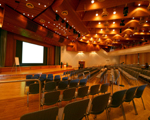Sure, we all agree that the principle of “garbage in garbage out” applies to audio-visual technology. But is “top of the line equipment” the real bottom line for state of the art web conferencing or videoconferencing? Answer: It’s one of the bottom lines, but not the only bottom line. There are a lot of other factors that go into optimizing a space for web or videoconferencing.
Having the right equipment is essential (cameras, codecs, monitors, microphones, etc) but equally important is the actual space where the equipment will be operated. Let’s start with the physical shape and size of the room and determine its size. How much space do you need?
First, consider the primary use of the space. Will there be: one user, a small group, or a presenter and an audience? Each answer requires a different sized room. A single user may choose to have the system installed in an office, but a presenter and audience combination will require a small auditorium or conference room where sight line studies will be appropriate. Another consideration is placement of entrances and exits. If the audience will enter or exit during the conference, the doors should be at the back of the space. The presenter, looking at the back of the room, will see anyone entering without having to turn away from the conferencing cameras.
Once the footprint is fixed, the ceiling height needs to be determined. A user that is seated will require a lower ceiling than a presenter standing on a short stage. When the presenter is on stage the camera view will affect the desired ceiling height. Lighting is another important part of this decision. Standard office overhead fluorescent fixtures may not be ideal for either seated or standing use. Rather, specialized lighting fixtures that evenly cover an area in a soft light will enhance the ability of the camera to capture a quality image. The lighting fixtures should be color corrected so that the presenter does not look green or blue on camera.
Windows also represent a challenge to the video conferencing space. Due to the changing light conditions from direct sun to bright cloudy to dark clouds, cameras may not correctly adapt to the changing conditions. Limiting the room to controlled lighting will allow the camera to be optimized for the environment.
The color of the wall behind the presenter is very important. The wall must be a neutral color that is neither too light nor too dark. The lighting of the space must also be coordinated with this wall color.
So far, we’ve only addressed some basic “visual” considerations for a web or videoconferencing space, but what about the optimizing the space for acoustics, so every seat is a good seat? What about eliminating background noise from HVAC units? What about distractions from outside the conference room? . . . I’ll leave that to our acoustical engineers. I’m an AVL guy.
This is why the services of an independent consultant can really help you out. At Acoustics By Design, we think about the end user, the owner, and the people who are left after the project is completed. We can help you make the right decisions from the start.
